Is Tracking My Food Necessary?
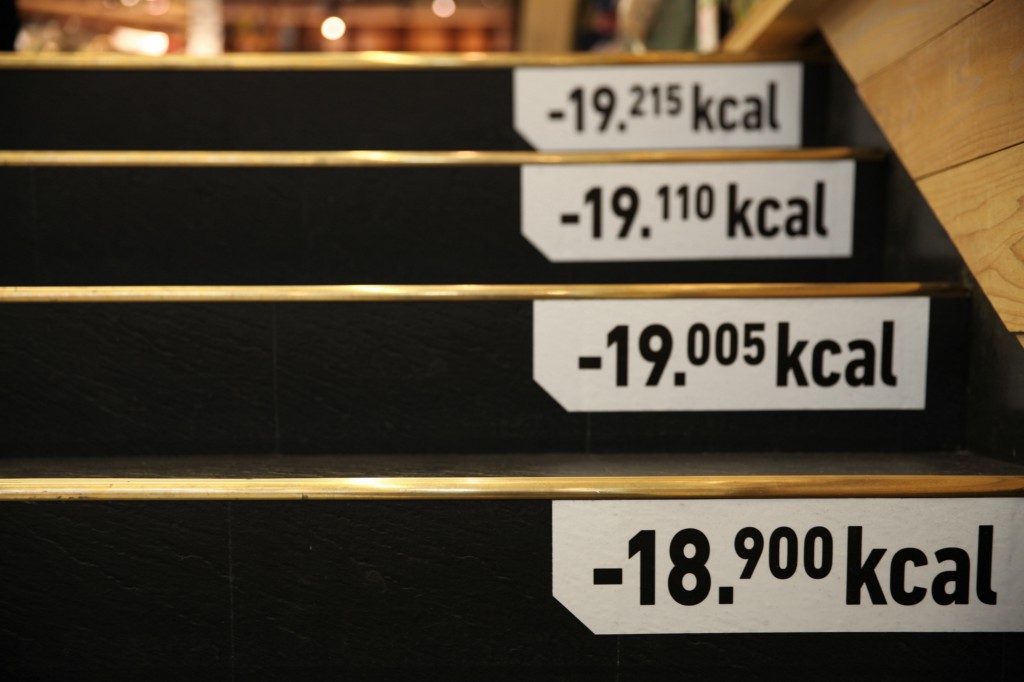
I’ve been going to the gym regularly for three years now and last spring started to get into powerlifting. Though I’ve taken care to get on a good lifting program, I haven’t paid much attention to my diet. I mean, I make an effort to eat protein whenever I can, but I don’t keep track of anything and my general principle simply has been to eat when I’m hungry. Am I undermining my work in the gym by not logging what I eat and hitting “my macros”? Am I destined to be counting the frozen cherries that go into my morning protein smoothie?
Thanks so much for all the good advice you’ve given so far! — Katerina
Firstly, yes, not getting all your food will absolutely undermine your progress in the gym. Not getting enough sleep and not drinking enough water will also undermine you. But, like everything, how much you pay attention to this stuff depends on your goals. If you are on more of a fuck-around exercise vibe and not trying to specifically do anything, you don’t have to… do anything. But if you are for instance, trying to cut fat, or trying to gain muscle, and logging hours and hours and the gym and copping the deepest of frowns every time you cross a mirror or look at your training log and see that you’ve made no progress, and yet you haven’t sorted out your food, well! Figuring out what food can do for you will definitely help.
Muscles are literally made of and fueled by food. I know you know that if you think about it a minute, but it somehow doesn’t stop a lot of people from treating exercise as a way of torturing their body into thinness, in spite of its realities. This serves only to make you miserable; it is even possible to exercise a lot and undereat and still gain weight, and it possible to diet away muscle, such that even if you “lose” all the “weight” you’re trying to, you can get right down to the bone without ever finding the muscle “tone” you expect to be there. You also cannot really get stronger without building muscle, and unless you are an extreme genetic outlier, it takes sustained effort to build even a little muscle. An average woman who is new to lifting can only gain about ten pounds of muscle in a year. It is a slow process even if you’re doing it absolutely correctly, so if you care about it, you should take the time to do it right.
Likewise, this may all be WAY too much for you and you’re just trying to figure out where you even are on the health spectrum. You can track just to get a sense of where you stand, without having to adhere to any particular strictures. The thing about food tracking is, it will probably be very illuminating as to what is in which foods, but just because you start tracking doesn’t mean you are shackled to it. Unless you have food or body image issues (in which case, please seek help from a professional and not me), you can just try it out, with the idea that eventually you will be in tune enough with the things you tend to eat you’ll be able to ease up on it. As with lifting, you have to give yourself enough time to get comfortable with it — say, a month — but you should always be able to live without it.
In the meantime, I think I can give you some MyFitnessPal tips that will make it easier to use. First, you have to set yourself up for success and at the bare minimum figure out your total daily energy expenditure, i.e. the number of calories you use in a day, and also your macros (how many grams of protein, carbs, and fat to eat). The xxfitness reddit has a very nice intro to all this.
If you want to go even further, the best book I’ve read about food and diet in relation to exercise/training is Renaissance Periodization’s Renaissance Woman. One of the best things I learned from it relevant to this is that months-long breaks from goal-driven dieting, whether you’re getting swole or ripped or jacked or cut, are not only psychologically necessary, they are physically necessary. You just can’t diet all the time, up or down! Your body tolerates it only to a certain extent. Even if you could somehow maintain the mental drive to track all the time and tweak your calories up and down, you can’t really. Your body and your brain need to not, sometimes. If you’re interested in learning more about that I highly, highly recommend the book.
Disclaimer: this is not an ad for MFP, and while I’ve tried out a bunch of tracking apps and systems and have a sometimes-contentious relationship with MFP — they went through an apparently rough period where interstitial full screen ads were popping up all over the place — it’s still the one that I feel has the best features for its quirks. Everything here is available to free users of the app; you can get more features if you subscribe, but I’ve never found this to be necessary.
Here are the things that about MFP that I’ve found make food logging easier. I hope they will last at least a while, since apps are changing all the time, but life is a highway and so forth:
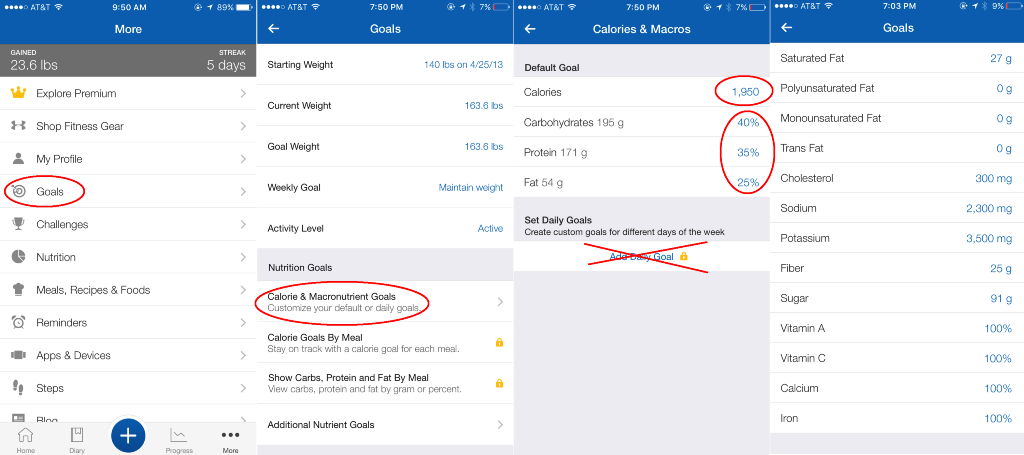
Custom macros. This is a trick I learned from r/xxfitness: pay no attention to either MFP exercise logging or the thing that tells you to put in a “goal weight.” Make your goal weight the weight you currently are and put your calories and macros in as custom numbers under the “goals” tab in Settings. You can’t put in exact macros, but you can get close enough. Modulate those numbers depending on whether you’re gaining muscle, maintaining, or losing fat. Never let MFP set them for you, it is bad at this.
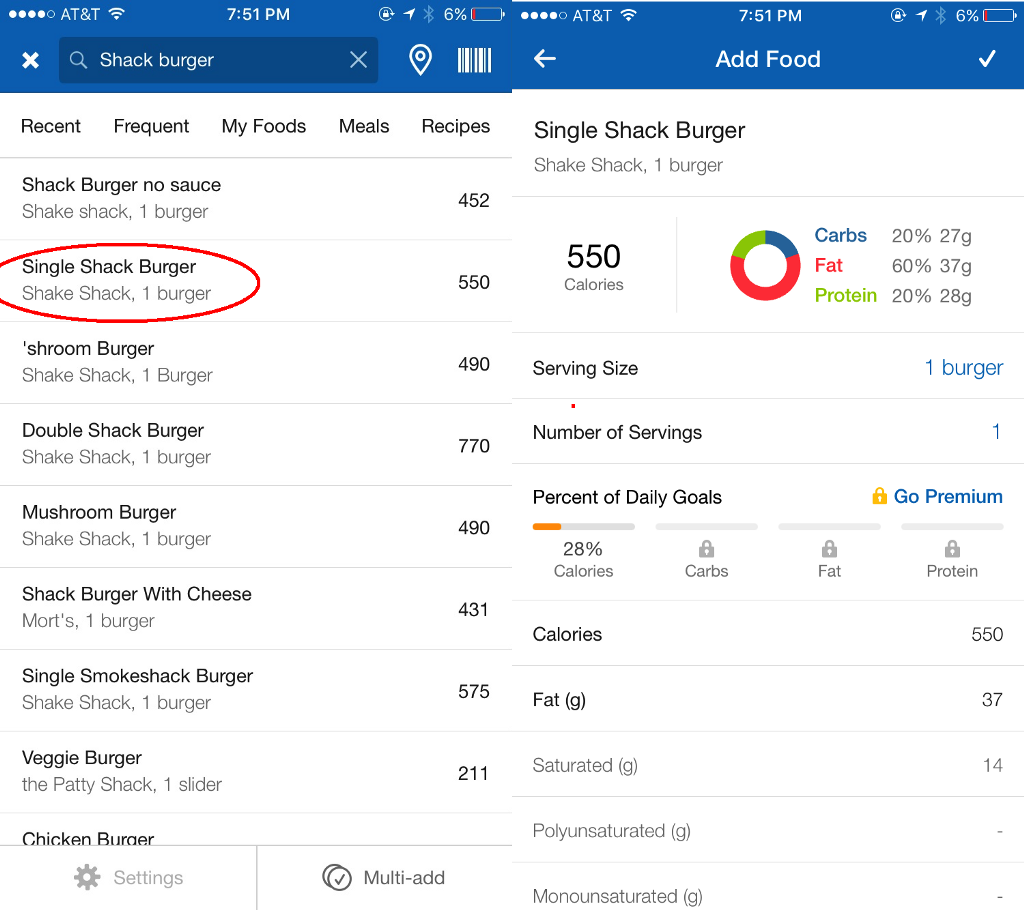
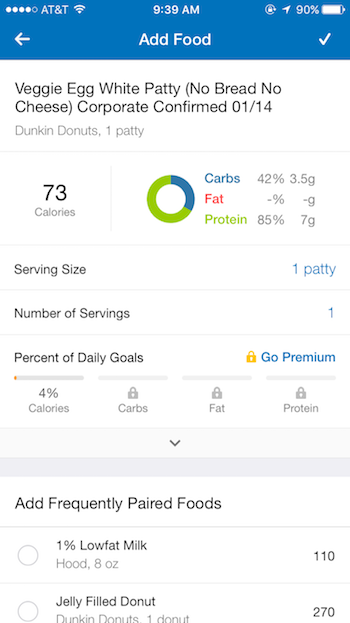
Many branded foods are in the app already. For instance, when I get a Shake Shack burger, I don’t have to individually add the burger patty, the piece of cheese, the mysterious and delicious Shack Sauce, the single tomato slice, the single lettuce leaf, the toasted (and buttered?) potato bun. I can just type in “Shack Burger” and add that food. The trick here is that, by law, restaurants with more than a certain number of stores have to make their nutrition info available, and odds are a poor hardworking MFP user has at some point in the past gone and added the prepared food you are eating from Chipotle or whatever. This includes many recipe mods — if I get an egg white flatbread from Dunkin Donuts with an extra egg white patty, and I search for “dunkin egg white,” the nutrition info for just that individual ingredient is in there, because someone went and called Dunkin and confirmed it. If I get a Shack Burger no sauce, or Shack Burger no bun, those are also in there.
Meal prep. A thing you inevitably discover at some point along the conscious food eating road is if you have food goals, and/or you’re trying to save money, it can be easier to meet them if you cook more at home and in volume. Having to decide What To Eat anew every meal takes a lot of decision-making power and consideration of how everything fits together, so if you’re any kind of busy person, having it already decided with something that you know you like to eat that is filling and basically nutritious leaves you alone to focus on more important stuff.
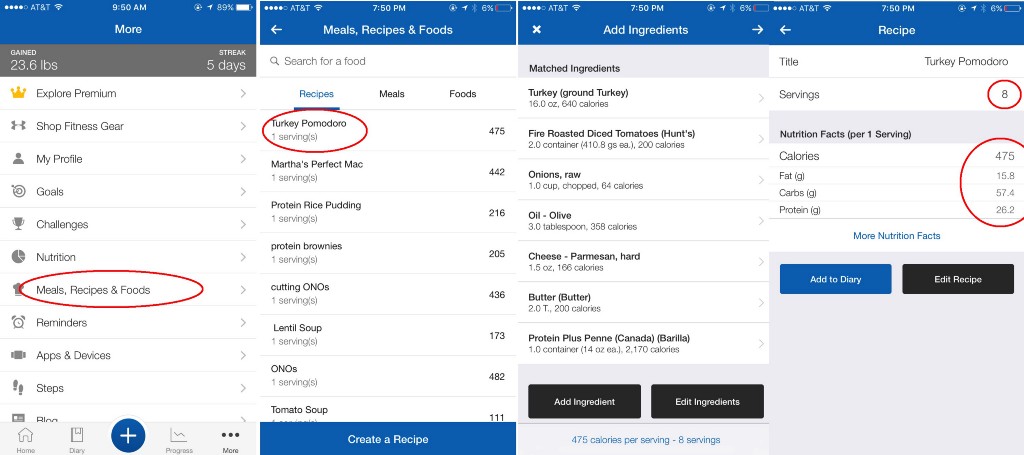
There are, fortunately, whole subreddits dedicated to meal prep. Also, one of my favorite article series on the whole internet is this Kitchn one about how a triathlete managed her food intake while getting ready for a competition. It gives interesting insight into keeping a large volume of food interesting and edible but also manageable.
Anyway, here is how MFP comes in: you may have noticed if you’ve used a tracking app before that adding anything with more than a few ingredients is pretty tiring. In MFP, you can create a “recipe” where you just add all its ingredients — box of pasta, can of tomatoes, olive oil, parmesan, ground turkey — and the app will auto-divide it into servings. When you eat a serving from your giant vat of ziti, just log the serving. Works also for volume swoalts, stews, soups, pasta, etc, etc.
Experimentation. MFP is handy to keep around to check the nutrition profile of new foods. Mostly I use it to sort of puzzle together a diet of normal foods in my orbit. I eat basically the same thing for breakfast every day (#swoalts) and also have a protein shake, so I know roughly where the pieces have to fall around those things. Unless you are a world traveler, you’ll find you probably tend to cycle between the same big group of foods. MFP remembers them, but you can also tweak servings up and down to make stuff fit. You can swipe forward to tomorrow and sort of plan out a menu for yourself, rather than flying by the seat of your pants. Or you can just use it to figure out the building blocks of food you know you’ll be eating, so if something comes up or you’re going out to eat, you can form up an idea of whether you want a pasta or a meat dish or a salad when that time rolls around. This is also just good for mindfulness — having an idea of what you’re going to eat when already can help stop you from grabbing at random snacks when you don’t need to, or if you’re bulking, let you know that you NEED to grab them because otherwise you won’t hit your calories.
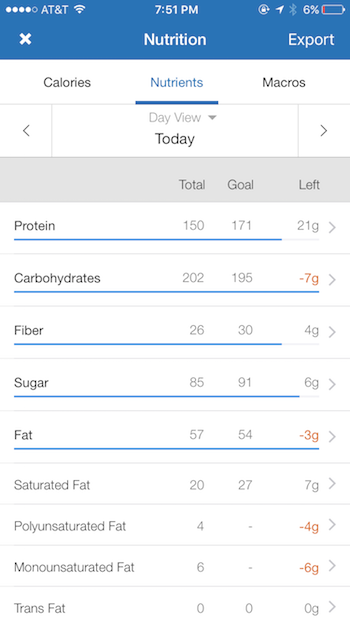
Ballparking. One popular weight-gain alarm bell is that an extra 100 calories per day adds up to however many pounds over the course of a year. But we’ve since learned that all calories are not equal. Nutrition labels are guidelines at best, they even have to round to the nearest ten calories. Sometimes MFP entries are a little wrong. And no energy expenditure calculator in the world is going to give you anything better than an estimate. We are all sort of just guessing here! Your body doesn’t really know or understand what you’re doing on a day-to-day basis. It is a bag of organs being electrically shocked into concerted action every few milliseconds. It’s better to think of food on a week-to-week basis. Holding yourself to shaving away another 17 calories or hunting down another couple grams of protein is almost certainly not worth the stress. If you encounter a strange non-Shake Shack burger, log the meat and the bun and pretend the sauce is “mayo” and call it a day. Do the best you can most days, aim for balance, and if you notice a trend over several days that you aren’t meeting your goals, make a bigger-picture change that addresses it rather than having to worry every day. MFP is for keeping track of these trends and guidelines, not for meeting every stricture to the exact digit.
Don’t use it. Sort of a corollary of above, but life is for living and food is fuel for your life. It’s part — a crucial part — of the positive feedback mechanism of taking care of yourself by exercising, or even better, building muscle and getting jacked and tan. I’m not a fan of eating “intuitively” when I have specific goals — I overeat when I try to lose fat and I undereat when I try to build muscle, and those are normal things to do. Part of this is that I don’t always have time to “listen to my body”; if I ignore it for a few hours I can miss out on a few hundred calories in either direction. But when I’m not doing either of those things, I don’t use MFP. After you log for a while to get a sense of everything, you kind of know what’s what and can stop keeping close track, or stop tracking entirely. It’s a tool, not a lifestyle.
Got a question for A Swole Woman? Email [email protected]. You can also follow her on Instagram or Facebook.